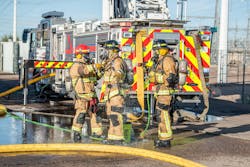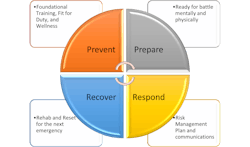Accountability Is Everyone’s Responsibility
When you hear the word “accountability,” what are your first thoughts? Are we talking about a human resources or performance issue, such as holding someone accountable for something that they did wrong?
Or are we talking about utilizing personal accountability report (PAR) tags and hose tags to track personnel in the hot zone?
Put another way, is accountability a passive or active process? Accountability should be thought of as an active process that engages not only the individual but the entire crew—from its most basic concept to its most complex.
Merriam-Webster defines accountability as “an obligation or willingness to accept responsibility or account for one’s actions.” For the fire service’s purposes, I would tack on “and each other’s actions.” We are a team. We all should watch out for each other as well as ourselves.
Multidimensional accountability
Accountability that pertains to the individual and the group falls under a concept that I call crew-based accountability. It starts with personal accountability and ends with the responsibility of each person on the crew as well as the organization.
The current accountability process in the fire service could be construed as a one-dimensional system. Its sole focus is on the capability to track crews on an incident.
Crew-based accountability is a holistic and multifaceted approach, which places a shared sense of responsibility on the organization, the supervisor and the individual. This adds additional layers of safety on the incident. This is accomplished by utilizing an active and cyclical process that focuses on four areas: prevention, preparation, response and recovery. (Some might recognize the process from its common use in emergency management.)
Crew-based accountability and its four-pronged process is based on the common identifiable unit in the fire service—a crew—which I also refer to as the family unit. After all, a crew has communal needs and the support that would be expected from a family—i.e., watch out for each other, take care of each other and help each other to succeed. This active cyclical method helps to reduce the risk of something bad happening, which is the motivation of the concept.Prevent
The focus in this segment of the cycle highlights the importance of ensuring that the foundational expectations are met, as are the minimum prerequisites that must be completed prior to being assigned on a fire truck. Those minimums are based on: the fit-for-duty medical examination of NFPA 1582: Standard on Comprehensive Occupational Medical Program for Fire Departments; fundamental and advanced training requirements; and continuing education specific to the assignment. In addition, the organization must ensure that an individual’s physical and mental health is monitored continually for optimum performance and resiliency. The basic assumption of this foundation is that a well-trained and physically prepared firefighter has the greatest chance of success and survival on an incident.
Prepare
Preparation for the shift or work assignment starts with an individual’s ability to be physically and mentally ready for battle. A firefighter should be well-rested, hydrated and focused on the mission.
A company officer should be ready personally for battle but also ready to lead the crew into the battleground. The leader has the immense responsibility of verifying the operational readiness of his/her crew—their personal readiness, mental well-being, ability to work together, experience level, individual abilities and ongoing condition throughout the shift. We must manage the work and rest cycle during the workday to make certain that the crew always is ready for the next call.
Also, we must ensure equipment is in good working order, the accountability/passport system utilized is up to date with the crew on duty, and appropriate staffing exists on your unit and at adjacent stations.
Ensuring crew preparedness helps the company officer to understand his/her crew’s level of abilities and potential limitations when responding to a call or getting a tactical order from command. This, in turn, helps with identifying future needs for additional resources and aids in knowing whether the task and objective can be accomplished by the personnel.
Respond
When responding, follow all driving protocols, wear your seatbelts and be alert. Share the dispatch information with the crew, discuss knowledge of the building and experiences of prior events or walk-throughs, and, depending on the situation, discuss relevant expectations. This begins the first phase of discretionary time, before decisions on initial actions at the event must be made.
When you arrive, operate within the risk-management plan:
- Green—We will risk our lives a lot, in a calculated manner, to save savable lives
- Yellow—We will risk our lives a little, in a calculated manner, to save savable property
- Red—We won’t risk our lives at all for lives or property that already are lost
As many of you will recognize, actions “in a calculated manner” require the following:
- Incident command is established
Proper PPE
Accountability system is established
Safety procedures are in place
Continuous risk-assessment is conducted by all members
Uninterrupted communications
These protocols and procedures are of utmost importance and shall be followed during all emergency operations and on every emergency incident. The risk-management plan creates the “why” regarding risk that is taken at an event. What is risk? Simply put, risk is injury or death to firefighters. We bring risk to the events. This reality must be understood by all firefighters, not just command officers.
Building on this foundation, always ensure the tactics and the tasks meet the strategy (offensive or defensive). Keep communications strong over the radio and within the crew. Manage air tied to work/rest cycles. Be situationally aware, avoid complacency, and monitor each other’s physical and mental status throughout the event. Keep a close eye on one another.
Recover
Recovery, including rehab and reset, is a very important last part to the crew-based accountability cycle. Implement a full NFPA-compliant rehab. Ensure that carcinogenic exposure reduction measures are in place and that the team is ready for the next call before going available. This means that everyone is mentally and physically ready to respond to the next emergency.
When you return to the station, fill out an exposure report if you were in the hot zone for tracking purposes with respect to the cancer risks that are associated with our profession. If you ran on a high-stress (mentally traumatic) incident, ensure that you have a process, such as the IAFF Peer Support program, to take care of your people and their well-being. On these types of incidents, it’s recommended that you have some process to track this type of mental exposure because of the potential for post-traumatic stress from the job.
Safer
When we think about the ability to be successful on an event, the crew-based accountability cycle plays the biggest proactive role in firefighter survivability on an event. Coming to the incident well-trained and ready to work with the right people makes for a safer event for all firefighters.
About the Author
Eric Valliere
Eric Valliere has been an active member of the fire service for 29 years. During his career, he held the rank of firefighter, engineer, captain, battalion chief and deputy fire chief. Valliere currently is assistant fire chief of emergency services with the Scottsdale, AZ, Fire Department. He is the vice chair of the Fire Department Safety Officers Association (FDSOA). Valliere has associate degrees in business administration and fire science from Mesa Community College and a bachelor’s degree in business administration and finance from Columbia Southern University. He has been an FDSOA ProBoard nationally certified Incident Safety Officer since 2004 and has a Chief Fire Officer designation. Valliere is the chair of the Phoenix Regional Valley Safety Officers Committee and the co-chair of the Regional Operations Consistency Committee within the Central Arizona Life Safety Council.

